Haryana State Board HBSE 10th Class Maths Solutions Chapter 10 Circles Ex 10.2 Textbook Exercise Questions and Answers.
Haryana Board 10th Class Maths Solutions Chapter 10 Circles Ex 10.2
In question 1 to 3, choose the correct option and give justification :
Question 1.
From a point Q, the length of the tangent to a circle is 24 cm and the distance of Q from the centre is 25 cm. The radius of the circle is :
(a) 7 cm
(b) 12 cm
(c) 15 cm
(d) 24.5 cm
Solution :
OP ⊥ PQ [By theorem 10.1]
In right ∆OPQ, we have
OQ2 = QP2 + OP2
[By Pythagoras theorem]
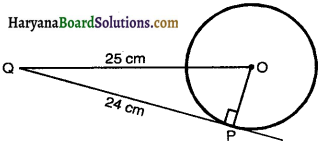
252 = 242 + OP2
OP2 = 252 – 242
⇒ OP2 = (25 + 24) (25 – 24)
⇒ OP2 = 49
⇒ OP = √49 = 7
∴ Radius = 7 cm
So, correct option is (a).
![]()
Question 2.
In the given figure, if TP and TQ are two tangents to a circle with centre O, so that ∠POQ = 110°, then ∠PTQ is equal to :
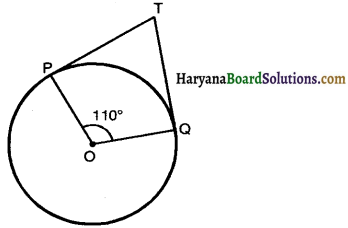
Solution:
∠OPT = ∠OQT = 90° (By theorem 10.1)
In a quadrilateral POQT, we have
∠OPT + ∠OQT + ∠POQ + ∠PTQ = 360°
⇒ 90° + 90° + 110° + ∠PTQ = 360°
⇒ 290° + ∠PTQ = 360°
⇒ ∠PTQ = 360° – 290°
⇒ ∠PTQ = 70°
The correct option is (b).
Question 3.
If tangents PA and PB from a point P to a circle with centre O are inclined to each other at angle of 80°, then ∠POA is equal to :
(a) 50°
(b) 60°
(c) 70°
(d) 80°
Solution :
OA ⊥ AP and OB ⊥ PB (By theorem 10.1)
In AOAP and AOBP, we have
AO = OB (radii of the same circle)
∠OAP = ∠OBP (each is 90°)
PO = OP (common)
∆OAP = ∆OBP (By R.H.S. congruence)
∠APO = ∠BPO (By CPCT)
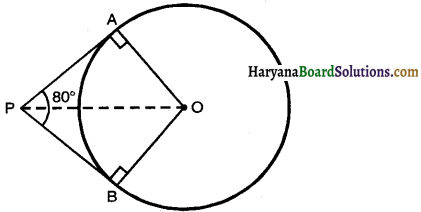
⇒ 40° + 90° + ∠POA = 180°
⇒ 130° + ∠POA = 180°
⇒ ∠POA = 180° – 130° = 50°
Hence, correct option is (a).
![]()
Question 4.
Prove that the tangents drawn at the ends of a diameter of a circle are parallel.
Solution:
Given : AB, CD are two tangents at the ends of a diameter PQ of a circle with centre O.
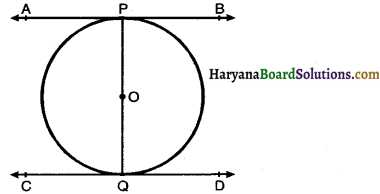
To Prove: AB || CD
Proof : OP ⊥ AB [By theorem 10.1]
OQ ⊥ CD[By theorem 10.1]
∠APQ = 90° and ∠CQP = 90°
∠APQ + ∠CQP = 90° + 90° = 180°
But these are co-interior angles.
∴ AB || CD Hence Proved.
Question 5.
Prove that the perpendicular at the point of contact to the tangent to a circle passes through the centre.
Given :
A circle with centre O and a tangent AB at point P.
To Prove : OP passes through centre.

Proof : AB is a tangent at point P and OP is the radius of circle.
If we have some points m, n on tangent AB. Then we find that OP is the shortest line from O in comparison of Om and On.
Therefore, OP ⊥ AB.
Hence, perpendicular OP drawn to tangent line at P passess through the centre (O) of the circle.
Hence Proved.
![]()
Question 6.
The length of a tangent from a point A at distance 5 cm from the centre of the circle is 4 cm. Find the radius of the circle.
Solution :
OB ⊥ AB (By theorem 10.1)
In right ∆ABO, we have
AO2 = AB2 + OB2 [By Pythagoras theorem]
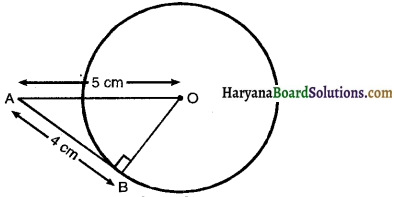
⇒ 52 = 42 + 62
⇒ OB2 = 52 – 42
⇒ OB2 = 25 – 16
⇒ OB2 = 9
⇒ OB = √9 = 3
Hence, radius of the circle is 3 cm.
Question 7.
Two concentric circles are of radii 5 cm and 3 cm. Find the length of the chord of the larger circle which touches the smaller circle.
Solution:
Let O be the centre of two concentric circles of radii 5 cm and 3 cm.
Let AB be a chord of the larger circle touching the smaller circle at P. Then
OP = 3 cm and AO = 5 cm OP ⊥ AB and AP = PB
In right ∆OPA, we have

AO2 = AP2 + OP2
52 = AP2 + 32
AP2 = 52 – 32
AP2 = (5 + 3) (5 – 3)
AP2 = 8 × 2 = 16
⇒ AP = √16 = 4
AB = 2 × AP = 2 × 4 = 8
Hence, length of chord is 8 cm.
![]()
Question 8.
A quadrilateral ABCD is drawn to circumscribe a circle (see figure below). Prove that: AB + CD = AD + BC
OR
A circle touches all the four sides of a quadrilateral ABCD. Prove that AB + CD = BC + DA.
Solution:
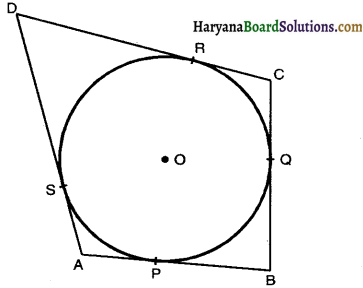
Given : A quadrilateral ABCD is drawn to circumscribe a circle.
To Prove : AB + CD = AD + BC
Proof : By theorem 10.2
We know that tangents drawn from an exterior point to a circle are equal in length.
AP = AS …..(1) [Tangents from point A]
PB = BQ ….(2) [Tangents from point B]
CR = QC ….(3) [Tangents from Point C]
DR = DS ….(4) [Tangents from point D]
Adding (1), (2), (3) and (4), we get
AP + PB + CR + DR = AS + BQ + QC + DS
⇒ AB + CD = AS + DS + BQ + QC
⇒ AB + CD = AD + BC
Hence Proved.
Question 9.
In the given figure XY and X’Y’ are two parallel tangents to a circle with centre O and another tangent AB with point of contact C intersecting XY at A and X’Y’ at B. Prove that ∠AOB = 90°.

Solution:
Given : Tangent XY || Tangents X’Y’ and another Tangent AB with point of contact C intersect XY at A and X’Y’ at B.
To Prove : ∠AOB = 90°
Construction : Join OC
Proof : In ∆APO and ∆ACO
AP = AC (By Theorem 10.2)
∠APO = ∠ACO = 90° (By theorem 10.1)
AO = AO (Common)
∆APO s ∆ACO (By RHS congruence)
∠PAO = ∠CAO (By CPCT)
⇒ 2 ∠CAO = ∠PAC ……………..(1)
Similarly, 2 ∠CBO = ∠QBC …………..(2)
Now, ∠PAC + ∠QBC = 180° [co-interior ∠s of same side]
2 ∠CAO + 2 ∠CBO = 180° [Using (1) and (2)]
⇒ ∠CAO + ∠CBO = \(\frac{180^{\circ}}{2}\) = 90“
⇒ ∠BAO + ∠ABO = 90°
In A AOB, we have
∠BAO + ∠AOB + ∠ABO = 180°
⇒ ∠AOB + 90° = 180° [Using (3)]
⇒ ∠AOB = 180° – 90° = 90°.
Hence Proved.
![]()
Question 10.
Prove that the angle between the two tangents drawn from an external point to a circle is supplementary to the angle subtended by the line segment joining the points of contact at the centre.
OR
In the given figure, O is the centre of a circle and two tangents CA, CB are drawn on the circle from a point C lying outside the circle. Prove that ∠AOB and ∠ACB are supplimentary.
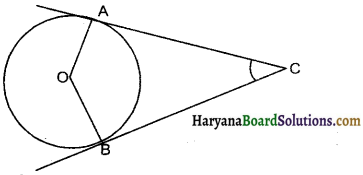
Solution:
Given : PA and PB be two tangents drawn from an external point P to a circle with centre O. Also, the line segments OA and OB are drawn.
To Prove : ∠APB + ∠AOB = 180°
Proof: PA ⊥ OA and
PB ⊥ OB [By theorem 10.1]

i.e. ∠PAO = 90° and ∠PBO = 90°
∠PAO + ∠PBO = 180° ………………..(1)
We know that sum of ∠s of a quadrilateral 360°.
∠APB + ∠AOB + ∠PAO + ∠PBO = 360°
⇒ ∠APB + ∠AOB + 180° = 360°
⇒ ∠APB + ∠AOB = 360° – 180°
⇒ ∠APB + ∠AOB = 180°.
Hence Proved.
Question 11.
Prove that the parallelogram circumscri-bing a circle is a rhombus.
Solution:
Given: A parallelogram ABCD circumscribes a circle with centre O.
To Prove : AB = BC = CD = AD
Proof: By theorem 10.2 we know that lengths of tangents drawn from an exterior point to a circle are equal.
BQ = BP …(1) (Tangents from Point B]
QC = RC…(2) [Tangents from Point C]
SD = RD …(3) [Tangents from point D]
AS = AP …(4) [Tangents from point A]
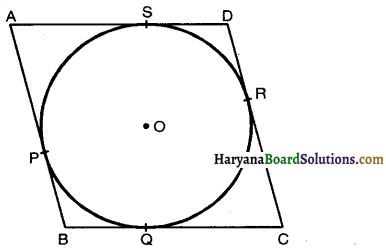
Adding (1), (2), (3) and (4), we get
BQ + QC + SD + AS = BP + RC + RD + AP
⇒ BC + AD = BP + AP + RC + RD
⇒ BC + AD = AB + CD
⇒ 2BC = 2AB
[∵ Opposite sides of ||gm are equal]
⇒ BC = AB
Since adjacent sides of a ||gm are equal]
∴ AB = BC = CD = AD.
Therefore, ABCD is a rhombus.
Hence Proved.
![]()
Question 12.
A triangle ABC is drawn to circumscribe a circle of radius 4 cm such that the segments BD and DC into which BC is divided by the point of contact D are of lengths 8 cm and 6 cm respectively (see figure). Find the sides AB and AC.
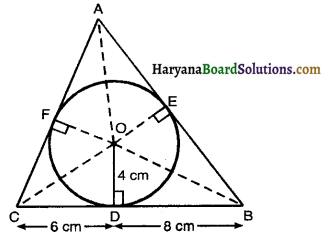
Solution:
Let tangents AB, BC and AC touch the circle at points E, D and F respectively. Join OE, OF, OA, OC and OB.
By theorem 10.2, we know that lengths of tangents drawn from an external point to the circle are equal.
CF = CD = 6 cm
BE = BD = 8 cm
AF = AE
Let AF = AE = x cm
AC = (6 + x) cm and AB = (8 + x) cm
∴ s = \(\frac{a+b+c}{2}\)
[Where a, b and c are lengths of sides of ∆ABC]
s = \(\frac{14+6+x+8+x}{2}\)
s = \(\frac{28+2 x}{2}\)
s = 14 + x
Area of ∆ABC = \(\sqrt{s(s-a)(s-b)(s-c)}\)
= \(\sqrt{\begin{array}{r}
(14+x)[14+x-14\} \\
\{14+x-6-x\} \\
{[14+x-8-x]}
\end{array}}\)
= \(\sqrt{(14+x)(x)(8)(6)}\)
= \(\sqrt{48 x(14+x)}\) cm2 ……………(1)
Now, OD ⊥ BC, OE ⊥ AB, OF ⊥ AC [By theorem 10.1]
Area of ∆ABC = Area of ∆BOC + Area of ∆AOB + Area of ∆AOC
= \(\frac{1}{2}\) (14) × 4 + \(\frac{1}{2}\) (8 + x) × 4 + \(\frac{1}{2}\) (6 + x) × 4
= 28 + 16 + 2x + 12 + 2x
= (56 + 4x) cm2 ……………….(2)
From (1) and (2), we get
\(\sqrt{48 x(14+x)}\) = 56 + 4x
Squaring both sides, we get
48x (14 + x) = (56 + 4x)2
⇒ 48x (14 + x) = 16 (14 + x)2
⇒ 3x (14 + x) = (14 + x)2
⇒ 3x = \(\frac{(14+x)^2}{(14+x)}\)
⇒ 3x = 14 + x
⇒ 3x – x = 14
⇒ 2x = 14
⇒ x = \(\frac{14}{2}\) = 7
Length of AB = 8 + x = 8 + 7 = 15 cm
Length of AC = 6 + x = 6 + 7 = 13 cm
Hence, lengths of AB and AC are 15 cm and 13 cm.
![]()
Question 13.
Prove that opposite sides of a quadrilateral circumscribing a circle subtend supplementary angles at the centre of the circle.
Solution :
Given : A quadrilateral ABCD circumscribes a circles with centre O.

To Prove: ∠AOB + ∠COD = 180
and ∠AOD + ∠BOC = 180°
Construction : Join OP, OQ, OR and OS.
Proof: In ∆OPB and ∆OQB,
∠OPB = ∠OQB (each is 90°) ,
PB = QB(By theorem 10.2)
OB = OB (Common)
∆OPB = ∆OQB (By RHS congruence)
Similarly,
∠1 = ∠2 (By CPCT)
∠3 = ∠4
∠5 = ∠6
∠7 = ∠8
∵ Sum of ∠s of a quadrilateral is 360°.
∴ ∠1 + ∠2 + ∠3 + ∠4 + ∠5 + ∠6 + ∠7 + ∠8 = 360°
⇒ 2 (∠2 + ∠3) + 2 (∠6 + ∠7) = 360
[∵ ∠1 = ∠2, ∠4 = ∠3, ∠5 = ∠6 and ∠8 = ∠7]
and similarly, 2 (∠1 + ∠8) + 2 (∠4 + ∠5) = 360°
⇒(∠2 + ∠3) + (∠6 + Z7) = 180° and (∠1 + ∠8) + (∠4 + ∠5) = 180°
⇒ ∠BOC + ∠AOD = 180° and ∠AOB + ∠COD = 180°.
Hence Proved.